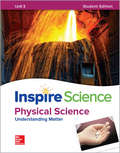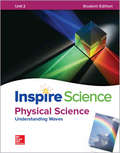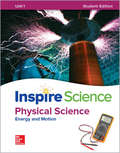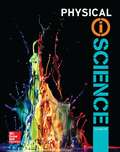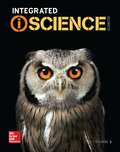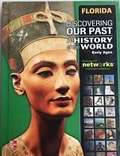- Table View
- List View
Glencoe Integrated iScience, Grade 8, Science Notebook
by McGraw-Hill EducationNIMAC-sourced textbook
Glencoe Integrated iScience, Grade 8
by Juli Berwald Michelle Anderson John BolzanNIMAC-sourced textbook
Inspire Science, Unit 4: Physical Science, Interactions of Matter
by Douglas Fisher Alton Biggs Ralph FeatherNIMAC-sourced textbook
Inspire Science, Unit 3: Physical Science, Understanding Matter
by Douglas Fisher Alton Biggs Ralph FeatherNIMAC-sourced textbook
Inspire Science, Unit 2: Physical Science, Understanding Waves
by Douglas Fisher Alton Biggs Ralph FeatherNIMAC-sourced textbook
Inspire Science, Unit 1: Physical Science, Energy and Motion
by Douglas Fisher Alton Biggs Ralph FeatherNIMAC-sourced textbook
Inspire Science, Unit 1: Life Science, Interactions Within Ecosystems
by Douglas Fisher Ralph M. Feather Jr. Alton L. BiggsNIMAC-sourced textbook
Humans and Their Place in the Universe (Inspire Science, Grade 8 Integrated #Unit 4)
by Douglas Fisher Ralph M. Feather Alton L. BiggsNIMAC-sourced textbook
Understanding Waves (Inspire Science, Grade 8 Integrated #Unit 3)
by Douglas Fisher Ralph M. Feather Alton L. BiggsNIMAC-sourced textbook
Inspire Science, Grade 8 Integrated, Unit 2: Energy and Motion
by Douglas Fisher Ralph M. Feather Alton L. BiggsNIMAC-sourced textbook
Change Over Time (Inspire Science, Grade 8 Integrated #Unit 1)
by Douglas Fisher Ralph M. Feather Alton L. BiggsNIMAC-sourced textbook
United States History & Geography, [Grade] 8: Colonization to Reconstruction
by Joyce Appleby Alan Brinkley Albert S. BroussardNIMAC-sourced textbook
Glencoe Integrated iScience: Interactive Science Essentials, Grade 8
by McGraw-Hill EducationNIMAC-sourced textbook
Glencoe Integrated iScience, Grade 8
by Juli Berwald Michelle Anderson John F. BolzanNIMAC-sourced textbook
Glencoe Physical iScience
by Mcgraw-Hill EducationContents in five units: Motion and Forces; Energy and Matter; Properties of Matter; Interactions of Matter; Waves, Electricity, and Magnetism.
Glencoe Integrated iScience, Course 3
by Juli Berwald Michelle Anderson American Museum of Natural HistoryNIMAC-sourced textbook
Matemáticas: Edición basada en los estándares comunes, CCSS, Curso 1, Volumen 1 (Math Applic And Conn Crse Ser.)
by Day Carter CuevasNIMAC-sourced textbook
Discovering Our Past: A History of the World, Early Ages
by Jackson J. SpielvogelNIMAC-sourced textbook
Discovering Our Past: A History of the World, Early Ages
by Jackson J. SpielvogelNIMAC-sourced textbook
Discovering Our Past: A History of the United States, Early Years, Chapter Tests & Lesson Quizzes
by McGraw-Hill EducationNIMAC-sourced textbook
United States History & Geography: Growth and Conflict
by Joyce Appleby Alan Brinkley Donald A. Ritchie Albert S. Broussard James M. McPhersoniScience [Grade 8]
by Juli Berwald Michelle Anderson American Museum of Natural HistoryNIMAC-sourced textbook


